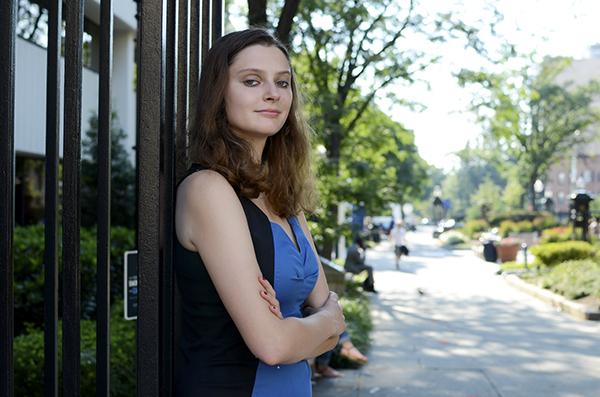Sophomore Eve Zhurbinskiy has big plans for the community now that she’s been named the newest commissioner for the Foggy Bottom and West End Advisory Neighborhood Commission.
Zhurbinskiy, who will be sworn in as an ANC commissioner by Foggy Bottom Council member Jack Evans this week, said in an interview she will continue working toward the ambitious goals she set during her campaign for the seat, like bringing forensic medical exams to GW Hospital and getting University Police Department officers to carry a drug that can reverse an overdose.
But experts say Zhurbinskiy’s ideas don’t always add up. A forensic medical exam, used to collect DNA evidence after a sexual assault, is expensive to conduct and requires significant training for nurses. And naloxone, the drug that reverses the effects of a prescription drug overdose, is not commonly carried by officers in campus police departments, especially on campuses with a hospital.
Zhurbinskiy is hoping to raise $700,000 — the amount needed to add forensic medical exams at GW Hospital — a goal she says is “completely fundable.” She said that she plans to meet with representatives of the hospital, GW, the D.C. government and other D.C. universities to convince them to help pay for the program.
“I think we can explore ways for the money to come in,” she said.
The ANC typically handles neighborhood concerns, like noise levels or construction. Peter Sacco, an alumnus whose seat Zhurbinskiy filled after his resignation, said in an interview that ANCs were created to be able to accomplish a “broad scope” of neighborhood issues.
“Advocating for rape kits could fall in line as it is a neighborhood issue and the GW Hospital is within her boundaries,” he said.
GW Hospital spokeswoman Susan Griffiths said the U.S. Department of Justice offered federal funding for the program, called a Sexual Assault Nurse Examiner (SANE) program, to a nonprofit hospital several years ago, but GW Hospital was ineligible because it is not a nonprofit. GW has a 20 percent stake in the hospital and the rest is owned by a separate corporation, University Health Services.
In order for a survivor to get the exam, they must go to MedStar Washington Hospital, about four miles from campus. Through a city-funded program, Uber provides free rides to the hospital, and trained advocates will meet the survivors there when they arrive.
“We recognize that each individual situation is different and work closely with the SANE program to ensure victims receive specialized care and assessment in an efficient manner that best meets their medical needs and preserves their dignity,” Griffiths said in an email.
Carey Goryl, the CEO of the International Association of Forensic Nurses, said the cost of the exams comes from aspects like specialized camera equipment to document small cuts or bruises. Nurses also must be taken out of their normal shift rotation to monitor the kit until it is processed, she said.
“It is not easy for them to leave the room and take care of other patients,” she said. “That costs money.”
Nikki Charles, executive director of the Network for Victim Recovery of D.C., said providing rape kits can be “extremely expensive” and that MedStar loses thousands of dollars because of the program.
“The hospital takes a loss for every patient that walks through the door,” Charles said.
Charles said Howard University was formerly the only academic institution in D.C. to provide rape kits to sexual assault survivors, but the program was discontinued in 2008. A Howard University student sued GW, GW Hospital, Howard University, Howard University Hospital and the city in 2007 saying they kept her from receiving the exam.
“When the program was taken away from Howard University, no other hospital wanted to host it,” Charles said.
Zhurbinskiy said that UPD officers and EMeRG staff should also carry naloxone to help prevent deaths by overdose and because city ambulances carry the drug. The drug, often referred to by its brand name of Narcan, can be administered as a nasal spray and has recently gained attention as a response to heroin overdoses.
“Every second counts in an overdose,” Zhurbinskiy said.
Boston University, one of GW’s peer schools, became the first university to have their campus police officers carry naloxone last year, according to the North Carolina Harm Reduction Coalition, a naloxone access advocacy group. The group’s website lists 16 other university police departments that carry the drug.
UPD officers and EMeRG staff, which is made up of students, do not currently carry Narcan.
UPD Chief RaShall Brackney said in an email that EMeRG follows city regulations and that emergency responders will “continue to follow guidelines as outlined and directed by DOH and to evaluate best practices and standards throughout the nation and university communities.”
William Bozeman, an emergency room doctor at Wake Forest Baptist Medical Center in North Carolina, said that while it’s not standard for local or campus police officers to carry naloxone, more and more departments are keeping it with them at all times because of a national uptick in overdoses.
According to a report from the Centers for Disease Control and Prevention released last year, 38 states have experienced an increase in heroin overdose deaths until 2012. D.C. was not on the list.
“It’s certainly becoming more common for police in general,” said Bozeman, who recently wrote a prescription for the drug for a city police department in Kernersville, N.C.
Ross Aikins, a University of Pennsylvania professor who specializes in collegiate substance abuse, said that if the University were to adopt the policy, officials would also need an amnesty policy to prevent possible sanctions from deterring students from reporting.
“If friends come clean and say something, it is important to develop amnesty policies for students so they don’t get in trouble,” Aikins said.
Robin Eberhardt contributed reporting.







